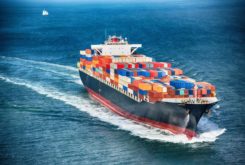Jair Bolsonaro has been president of Brazil for less than four months but his promises on transport sector deregulation are already under pressure. He pledged to break the country’s reliance on road haulage but has already been forced to give concessions to truck drivers in order to avert industrial action. Yet the lack of market liberalisation has not stymied Chinese interest in Brazilian port assets, which is being driven by Chinese interest in the country’s raw materials and Beijing’s eagerness to include Brazil in its Belt and Road Initiative.
The new government wants to reduce the number of managers at the nation’s ports, encourage the adoption of more efficient methods and increase private sector participation in port management. In February, PresidentBolsonaro announced that the government would issue tenders for ten port concessions before the end of June, including several at Cabedelo and Vitória, plus four at Santos in São Paulo, relating to smaller terminals and other facilities. It is hoped that the latter will raise US$125 million.
A range of infrastructural improvements are planned at Santos, which is the second biggest container port in Latin America after Colón in Panama, including dredging, improved rail and road access and warehouse upgrades. In addition to the concessions, an initial public offering (IPO) for equity in the port itself could be issued as soon as 2022.
Chinese firms could be interested in both the state privatisation programme and buying privately owned port facilities. Rio-based Wilson Sons is expected to sell off two port terminals: Tecon Rio Grande and Tecon Salvador, and China Merchant Holdings and Hutchison Port Holdings are believed to be among the interested parties. The two terminals have combined turnover of about 1.3 million TEU/year.
Some in the sector have complained about over regulation, including the requirement for private sector firms to secure the approval of the Agência Nacional de Transportes Aquaviários to operate port facilities. It can take years before the regulator sanctions applications.
Port of Paranagua
In September, China Merchants Port Holdings unveiled development plans for the Port of Paranagua (TCP) in southern Brazil. A total of US$113 million was invested in TCP between 2012 and 2016 to double its handling capacity to 1.5 million TEU. The minimum draft at the terminal berths will increase by 1m to 13.3m at low tide once the current dredging programme is completed, although even this means that very large cargo vessels will only be able to use the terminal at high tide. Talks are underway on a second dredging programme, which would deepen the minimum draft at 15m.
About 24% of the terminal’s exports are shipped to China and this proportion could increase as the facility’s capacity is expanded to 2.4 million TEU/year, hopefully by the end of this year at a cost of US$140.6 million. TEU stands for twenty foot equivalent units and is the standard measure of container turnover. Parent company China Merchants Group bought a 90% stake in the terminal’s operating company for US$935 million in 2017 as part of Beijing’s Belt and Road Initiative and TCP had its concession extended until 2048 last year.
The company’s vice president, Lu Yongxin, said: “We will work to make TCP one of the main business platforms between Brazil and China. Our goal is to become leaders in Latin America…China is Brazil’s largest importer of agricultural products, and Brazil is the largest importer of Chinese manufactured products, of every four containers, one is coming or going to China.” Lu revealed that China Merchants had decided in 2016 to acquire new port assets in the Americas.
Despite challenges, the attraction of Latin American ports to Chinese investors is obvious. Brazil in particular is a supplier of raw materials of global importance, while trade volumes between the region and the rest of the world are growing even during the current period of more limited economic growth. According to the UN’s Economic Commission for Latin America and the Caribbean, Latin American ports handled 7.7% more containers in 2018 than in 2017, with total turnover of 52.3 million TEU.
China’sShanghai Zhenhua Heavy Industries Company (ZPMC) is supplying many of the new cranes bought by Brazilian ports, including the four rubber tyred gantry cranes bought by Brasil Terminal Portuario at Santos.ZPMC is also due to deliver two super post-Panamax gantry cranes to TCP by the end of this year. TCP commercial director Alexandre Rubio said: “The size of the cranes is sufficient to meet the largest container ships that will dock in Brazil in the coming years. This means that we will be one of the few ports with all the necessary infrastructure to receive ships of 368 meters or more.”
Chinese demand
As well as investing in Brazilian projects, China is a huge market for Brazilian exports, including of agricultural and mining commodities. Vale, which accounts for about 80% of Brazilian iron ore exports, produces about 400 million tonnes/year, much of which is shipped to China. Tougher Chinese legislation on carbon emissions and particularly air pollution have seen Chinese demand for Vale’s higher grade iron ore increase, as the company wins market share from its Australian competitors.
Beijing had banned Vale big ore carriers from entering Chinese ports but the Brazilian giant’s new ‘guaibamax’ ore carriers have begun to move iron ore from Brazil to China for the first time. Vale expects to operate 47 of the 325,000 dwt vessels by 2023 but some analysts doubt whether owning and operating its own fleet is the best option.
The Sino-US trade war is also benefitting the Brazilian port sector, as Beijing has placed a 25% tariff on US soya imports, allowing Brazilian producers to increase their exports to Chinese consumers. According to figures from the Brazilian soya bean producers association, Aprosoja Brasil, 47% of the 114.1 million tonnes that Brazil produced in the 2016-17 growing season was exported to China but both figures are likely to rise in the near future.
Similarly, growing demand from China and other big consuming nations is driving investment in additional port capacity. Caramuru and Rumo are to increase the capacity of their grain terminal at Santos from 3 million tonnes/year to 5.7 million tonnes/year over the next two years, while the capacity of the Tegram grain terminal at the port of Itaqui is being doubled to 20 million tonnes/year by operatorTerminal Corredor Norte, which is owned by Glencore, Corredor Logistica and ALZ Terminais Portuarios. A second berth and another grain elevator are being added to the latter. The investors are considering whether to double capacity again to 40 million tonnes/year.
Strike fears
Last May’s truck drivers strike had a huge impact on the cargo industry and indeed on national politics. The rail network is fairly limited, so most freight, including mining and agricultural commodities, is transported by truck. An incredible 61% of Brazilian cargo is moved by road, even taking into account oil, which is moved by pipeline. As a result, the eleven day strike by independent truckers in protest against high diesel prices had a big effect on the economy.
The then-government set minimum prices for truck freight and introduced diesel subsidies to cut prices by 45 US cents a gallon. Although the new government promised to deregulate the economy, President Bolsonaro appears scared of provoking a re-run of the damaging strike and in April blocked Petrobras’ planned diesel price increases. The government has also promised to offer truckers access to new sources of credit to improve their operations. The only long term solution seems to be to move away from road haulage for long distance transport and towards more rail and water transport, but this will require government regulation and probably investment in long delayed infrastructure projects.
José Di Bella Filho, the CEO of the Brazilian Association of Port Terminals, said that the minimum freight rates had depressed cargo turnover at Brazil’s ports. He said: “The exporter loses competitiveness and the conditions to do business. He stops buying the product in the field and he doesn’t meet the commitments at the destination, and this leaves the Brazilian port without cargo”.
The truckers strike boosted the transport of cargo by sea between Brazilian ports, with an estimated 15% increase in coastal trade in 2018 in comparison with 2017. The three main coastal cargo operators: Aliança Navegação, Mercosul Line and Log-In Logistica moved more than 1 million TEU between Brazilian ports last year. Nevertheless, just 10% of all containers are transported by water, in comparison with an 80% market share for road haulage. Aliança Navegação hopes to buy two new vessels to expand its operations. Under Brazilian law, ships carrying cargo between Brazilian ports must be Brazilian flagged, although operators can be owned by foreign interests.
Fears of a new round of strikes increased in March when Santos, which handled 4.3 million TEU last year, was affected by a strike by casual port workers, with significant delays in vessels being loaded, unloaded or entering the port. Brasil Terminal Portuaria, which is owned by a consortium of China Merchant Holdings, CMA CGM and APM Terminals, built defences around the terminal using empty containers to keep the strikers out. Police and the navy were also deployed at the scene. Workers protested against the loss of work restricted to members of their representative organisations and claimed that rival workers were working longer than the maximum hours.*CLBrief



